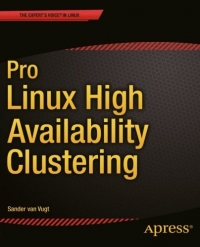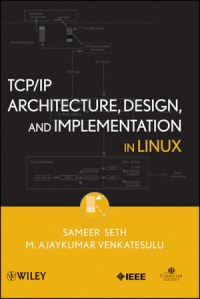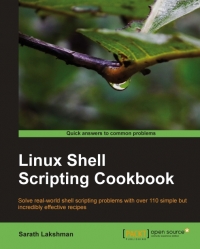Learn something new in an Instant! A short, fast, focused guide delivering immediate results.Install and configure Arch Linux to set up your optimum environment for building applications Boot and manage services, add and remove packages .Discover and get to grips with the features of the Linux Kernel
Kali Linux Wireless Penetration Testing
Master wireless testing techniques to survey and attack wireless networks with Kali Linux
As wireless networks become ubiquitous in our lives, wireless penetration testing has become a key skill in the repertoire of the professional penetration tester. The Kali Linux security distribution comes with a myriad of tools used for networking attacks and detecting security loopholes.
Kali Linux Wireless Penetration Testing Beginner's Guide presents wireless pentesting from the ground up, introducing all elements of penetration testing with each new technology. Learn various wireless testing methodologies by example, from the basics of wireless routing and encryption through to detailed coverage of hacking methods and attacks such as the Hirte and Caffe Latte.
Professional Xen Virtualization
Xen is an open source virtualization technology that allows multiple operating systems to run on a single physical computer system, providing cost savings and increased efficiency. This book presents you with a complete foundation on this exciting technology and shows you how Xen virtualization offers faster response times for new server and service requests, a simplified system administration for multiple systems, and better availability for critical computing resources.
You'll begin by examining the basic concepts of Xen as you also explore how to successfully make the most of today's virtualization technologies.
The Book of Xen
A Practical Guide for the System Administrator
Xen, the open source virtualization tool, is a system administrator's dream. Xen is a free, high-performance virtual machine monitor that lets you consolidate your hardware and finally put those unused cycles to use - without sacrificing reliability, performance, or scalability.
The Book of Xen explains everything you need to know in order to use Xen effectively, including installation, networking, memory management, and virtualized storage. You'll also learn how to use Xen and standard Linux tools to take snapshot backups, perform QoS operations on network traffic, and limit over-aggressive disk users.
Linux Command Line and Shell Scripting Bible
Linux Command Line and Shell Scripting Bible is your essential Linux guide. With detailed instruction and abundant examples, this book teaches you how to bypass the graphical interface and communicate directly with your computer, saving time and expanding capability. This third edition incorporates thirty pages of new functional examples that are fully updated to align with the latest Linux features. Beginning with command line fundamentals, the book moves into shell scripting and shows you the practical application of commands in automating frequently performed functions. This guide includes useful tutorials, and a desk reference value of numerous examples.
The Linux command line allows you to type specific shell commands directly into the system to manipulate files and query system resources. Command line statements can be combined into short programs called shell scripts, a practice increasing in popularity due to its usefulness in automation. This book is a complete guide providing detailed instruction and expert advice working within this aspect of Linux.
Linux Firewalls
Attack Detection and Response with iptables, psad, and fwsnort
System administrators need to stay ahead of new security vulnerabilities that leave their networks exposed every day. A firewall and an intrusion detection systems (IDS) are two important weapons in that fight, enabling you to proactively deny access and monitor network traffic for signs of an attack.
Linux Firewalls discusses the technical details of the iptables firewall and the Netfilter framework that are built into the Linux kernel, and it explains how they provide strong filtering, Network Address Translation (NAT), state tracking, and application layer inspection capabilities that rival many commercial tools. You'll learn how to deploy iptables as an IDS with psad and fwsnort and how to build a strong, passive authentication layer around iptables with fwknop
Linux Firewalls discusses the technical details of the iptables firewall and the Netfilter framework that are built into the Linux kernel, and it explains how they provide strong filtering, Network Address Translation (NAT), state tracking, and application layer inspection capabilities that rival many commercial tools. You'll learn how to deploy iptables as an IDS with psad and fwsnort and how to build a strong, passive authentication layer around iptables with fwknop
Linux Recipes for Oracle DBAs
Linux Recipes for Oracle DBAs is an example–based book on managing Oracle Database in a Linux environment. Covering commonly used distributions such as Red Hat Enterprise Linux and Oracle Enterprise Linux, the book is written for database administrators who need to get work done and lack the luxury of curling up fireside with a stack of Linux documentation. The book is task-oriented: Look up the task to perform. See the solution. Read up on the details. Get the job done.
Linux Recipes for Oracle DBAs is a book for Oracle database administrators who want to expertly operate Oracle databases on the Linux operating system. If you're new to Linux, or are migrating from a Unix platform, or just want detailed solutions for tasks that Oracle DBAs perform on Linux servers, this book is for you.
Pluggable Authentication Modules
The Definitive Guide to PAM for Linux SysAdmins and C Developers
PAM-aware applications reduce the complexity of authentication. With PAM you can use the same user database for every login process. PAM also supports different authentication processes as required. Moreover, PAM is a well-defined API, and PAM-aware applications will not break if you change the underlying authentication configuration.
The PAM framework is widely used by most Linux distributions for authentication purposes. Originating from Solaris 2.6 ten years ago, PAM is used today by most proprietary and free UNIX operating systems including GNU/Linux, FreeBSD, and Solaris, following both the design concept and the practical details. PAM is thus a unifying technology for authentication mechanisms in UNIX
Designing and Implementing Linux Firewalls and QoS using netfilter, iproute2, NAT and L7-filter
Learn how to secure your system and implement QoS using real-world scenarios for networks of all sizes
Implementing Packet filtering, NAT, bandwidth shaping, packet prioritization using netfilter/iptables, iproute2, Class Based Queuing (CBQ) and Hierarchical Token Bucket (HTB); Designing and implementing 5 real-world firewalls and QoS scenarios ranging from small SOHO offices to a large scale ISP network that spans many cities; Building intelligent networks by marking, queuing, and prioritizing different types of traffic.
Pro Linux High Availability Clustering
Pro Linux High Availability Clustering teaches you how to implement this fundamental Linux add-on into your business. Linux High Availability Clustering is needed to ensure the availability of mission critical resources. The technique is applied more and more in corporate datacenters around the world. While lots of documentation about the subject is available on the internet, it isn't always easy to build a real solution based on that scattered information, which is often oriented towards specific tasks only. Pro Linux High Availability Clustering explains essential high-availability clustering components on all Linux platforms, giving you the insight to build solutions for any specific case needed.
Kali Linux Network Scanning Cookbook
Over 90 hands-on recipes explaining how to leverage custom scripts, and integrated tools in Kali Linux to effectively master network scanning
Kali Linux Network Scanning Cookbook will introduce you to critical scanning concepts. You will be shown techniques associated with a wide range of network scanning tasks that include discovery scanning, port scanning, service enumeration, operating system identification, vulnerability mapping, and validation of identified findings. You will learn how to utilize the arsenal of tools available in Kali Linux to conquer any network environment. You will also be shown how to identify remote services, how to assess security risks, and how various attacks are performed. This immersive guide will also encourage the creation of personally scripted tools and the development of skills required to create them.
Practical Linux Infrastructure
Practical Linux Infrastructure teaches you how to use the best open source tools to build a new Linux infrastructure, or alter an existing infrastructure, to ensure it stands up to enterprise-level needs. Each chapter covers a key area of implementation, with clear examples and step-by-step instructions.
Using this book, you'll understand why scale matters, and what considerations you need to make. You'll see how to switch to using Google Cloud Platform for your hosted solution, how to use KVM for your virtualization, how to use Git, Postfix, and MySQL for your version control, email, and database, and how to use Puppet for your configuration management. For enterprise-level fault tolerance you'll use Apache, and for load balancing and high availability, you'll use HAProxy and Keepalived. For trend analysis you'll learn how to use Cacti, and for notification you'll use Nagios. You'll also learn how to utilize BIND to implement DNS, how to use DHCP (Dynamic Host Configuration Protocol), and how to setup remote access for your infrastructure using VPN and Iptables. You will finish by looking at the various tools you will need to troubleshoot issues that may occur with your hosted infrastructure. This includes how to use CPU, network, disk and memory management tools such as top, netstat, iostat and vmstat.
The Definitive Guide to SUSE Linux Enterprise Server 12
The Definitive Guide to SUSE Linux Enterprise Server 12 is a task-oriented book designed for self-study as well as classroom environments, which will also serve you as a reference guide. The book covers all skills that system administrators typically need to posses to administer SUSE Linux Enterprise Server in corporate environments. It starts at the beginning, which makes The Definitive Guide to SUSE Linux Enterprise Server 12 suitable for people without any preliminary Linux knowledge, and yet works up to advanced SUSE Linux administration tasks, such as building a cluster, optimizing performance or managing SUSE Linux Enterprise Server with SUSE Manager.
Understanding Linux Network Internals
Guided Tour to Networking in Linux
Download E-book
If you've ever wondered how Linux carries out the complicated tasks assigned to it by the IP protocols - or if you just want to learn about modern networking through real-life examples - Understanding Linux Network Internals is for you.
This book clearly explains the underlying concepts and teaches you how to follow the actual C code that implements it. Although some background in the TCP/IP protocols is helpful, you can learn a great deal from this text about the protocols themselves and their uses. And if you already have a base knowledge of C, you can use the book's code walk throughs to figure out exactly what this sophisticated part of the Linux kernel is doing.
Download E-book
TCP/IP Architecture, Design and Implementation in Linux
This book provides thorough knowledge of Linux TCP/IP stack and kernel framework for its network stack, including complete knowledge of design and implementation. Starting with simple client-server socket programs and progressing to complex design and implementation of TCP/IP protocol in linux, this book provides different aspects of socket programming and major TCP/IP related algorithms. In addition, the text features netfilter hook framework, a complete explanation of routing sub-system, IP QOS implementation, and Network Soft IRQ. This book further contains elements on TCP state machine implementation,TCP timer implementation on Linux, TCP memory management on Linux, and debugging TCP/IP stack using lcrash.
Pro Bash Programming
The bash shell is a complete programming language, not merely a glue to combine external Linux commands. By taking full advantage of shell internals, shell programs can perform as snappily as utilities written in C or other compiled languages. And you will see how, without assuming Unix lore, you can write professional bash 4.0 programs through standard programming techniques.
Linux Shell Scripting Cookbook
Solve real-world shell scripting problems with over 110 simple but incredibly effective recipes
GNU/Linux is a remarkable operating system that comes with a complete development environment that is stable, reliable, and extremely powerful. The shell being the native interface to communicate with the operating system is capable of controlling the entire operating system. There are numerous commands on Linux shell which are documented but hard to understand. The man pages are helpful but they are very lengthy and it does not give any clues on key areas where commands can be used. Proper usage of shell commands can easily solve many complex tasks with a few lines of code, but most linux users don't have the right know-how to use the Linux shell to its full potential.
Linux Command Line and Shell Scripting Bible
The Linux command line allows you to type specific Linux commands directly to the system so that you can easily manipulate files and query system resources, thereby permitting you to automate commonly used functions and even schedule those programs to run automatically. This new edition is packed with new and revised content, reflecting the many changes to new Linux versions, including coverage of alternative shells to the default bash shell. In addition, this edition features a host of real-world examples, so you can see how the scripts work in application.
Shell Scripting
Expert Recipes for Linux, Bash and more
The shell is the primary way of communicating with Unix and Linux systems, providing a direct way to program by automating simple to intermediate tasks. In this invaluable resource, Unix, Linux, and shell scripting expert Steve Parker shares a collection of shell scripting recipes that can be used as provided or easily modified for a variety of environments and situations. The book begins with coverage of theory and principles, replete with insightful examples of each element discussed. You then move on to an in-depth discussion of shell programming, covering all Unix flavors but with a focus on Linux and the Bash shell. All the while, you explore credible, real-world recipes and the tools necessary to get started immediately.
Linux Kernel Development, 3rd Edition
A thorough guide to the design and implementation of the Linux kernel
Linux Kernel Development details the design and implementation of the Linux kernel, presenting the content in a manner that is beneficial to those writing and developing kernel code, as well as to programmers seeking to better understand the operating system and become more efficient and productive in their coding.
The book details the major subsystems and features of the Linux kernel, including its design, implementation, and interfaces. It covers the Linux kernel with both a practical and theoretical eye, which should appeal to readers with a variety of interests and needs.
The author, a core kernel developer, shares valuable knowledge and experience on the 2.6 Linux kernel. Specific topics covered include process management, scheduling, time management and timers, the system call interface, memory addressing, memory management, the page cache, the VFS, kernel synchronization, portability concerns, and debugging techniques. This book covers the most interesting features of the Linux 2.6 kernel, including the CFS scheduler, preemptive kernel, block I/O layer, and I/O schedulers.
Pro Ubuntu Server Administration
Pro Ubuntu Server Administration teaches you advanced Ubuntu system building. After reading this book, you will be able to manage anything from simple file servers to multiple virtual servers to high - availability clusters. This is the capstone volume of the Apress Ubuntu trilogy that includes Beginning Ubuntu Linux, Third Edition and Beginning Ubuntu Server LTS Administration: From Novice to Professional, Second Edition. You will be able to make Ubuntu technology shine in a Fortune 500 environment and let Ubuntu server become the backbone of your infrastructure
Beginning Ubuntu Linux, 5th Edition
Ubuntu Linux is the fastest growing Linux - based operating system, and Beginning Ubuntu Linux, Fifth Edition teaches all of us - including those who have never used Linux - how to use it productively, whether you come from Windows or the Mac or the world of open source.
Beginning Ubuntu Linux, Fifth Edition shows you how to take advantage of Lucid Lynx. Based on the best-selling previous edition, Emilio Raggi maintains a fine balance between teaching Ubuntu and introducing new features. Whether you aim to use it in the home or in the office, you'll be introduced to the world of Ubuntu Linux, from simple word processing to using cloud services. You'll learn how to control the Ubuntu system, which you just installed from the book's DVD, as you are guided through common tasks such as configuring the system's graphical user interface (GUI), listening to audio CDs and MP3s, producing documents, using VoIP and chat, and of course, general system maintenance.
Linux System Administration Recipes
A Problem-Solution Approach
Download E-book
The job of Linux systems administrator is interrupt-driven and requires constant learning in byte-wise chunks. This book gives solutions to modern problems-even some you might not have heard of-such as scripting LDAP, making Mac clients play nice with Linux servers, and backup, security, and recovery scripts. Author Juliet Kemp takes a broad approach to scripting using Perl and bash, and all scripts work on Debian or Red Hat lineage distributions. Plus, she dispenses wisdom about time management, dealing with desperate colleagues, and how to avoid reinventing the wheel!
Download E-book
Linux Cookbook 2nd Edition
The Linux Cookbook, 2nd Edition is your guide to getting the most out of Linux. Organized by general task (such as working with text, managing files, and manipulating graphics), each section contains a series of step-by-step recipes that help you to get your work done quickly and efficiently, most often from the command line. Nearly 50 percent larger than the first edition, this new edition includes hundreds of new recipes as well as new sections on package management; file conversion; multimedia; working with sound files (including OGG and MP3); Vi text editing; advanced text manipulation; and more. Perfect as an introduction to Linux, or as a desktop reference for the seasoned user. Covers the major Linux distributions.
Subscribe to:
Comments (Atom)























